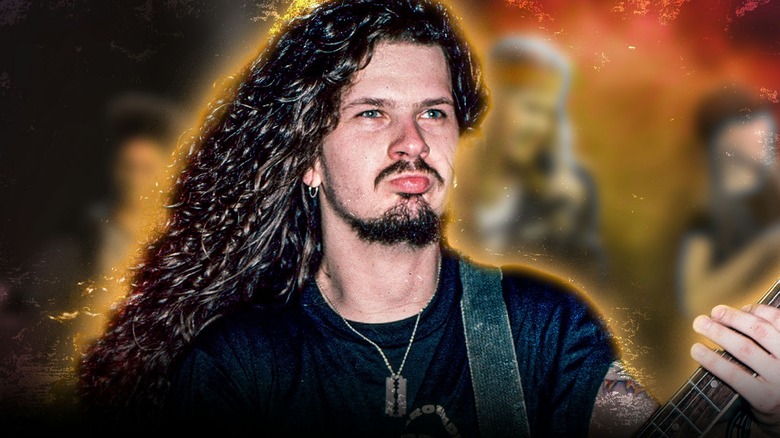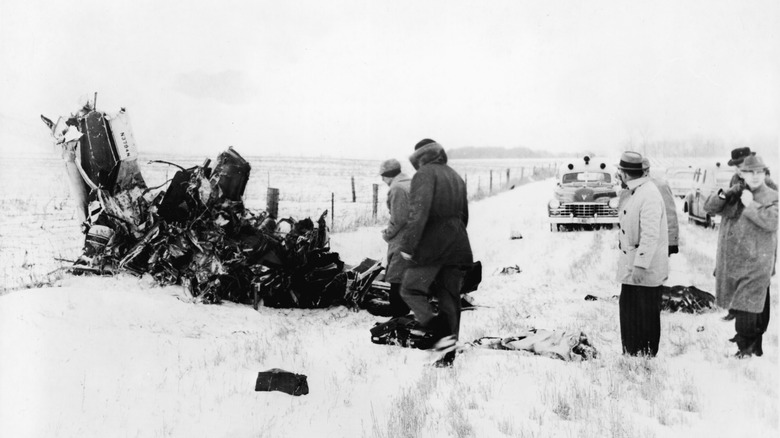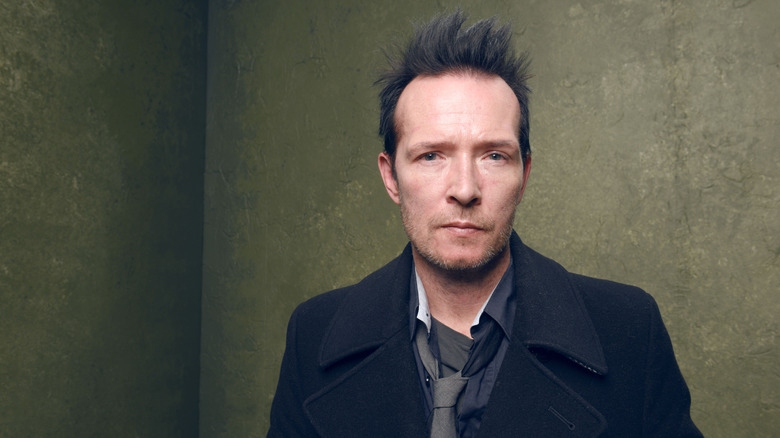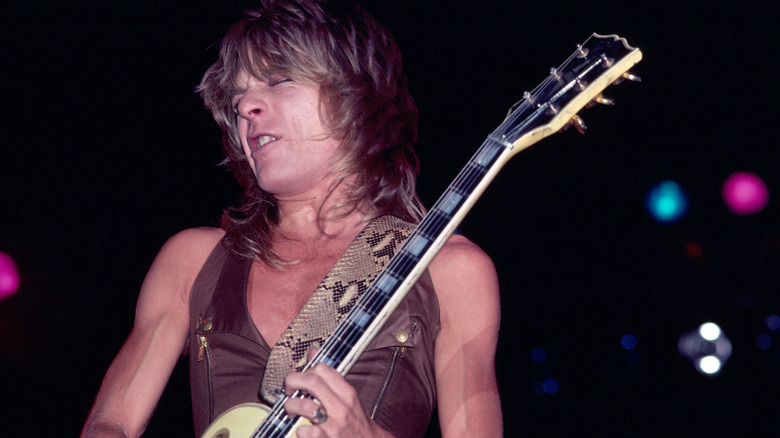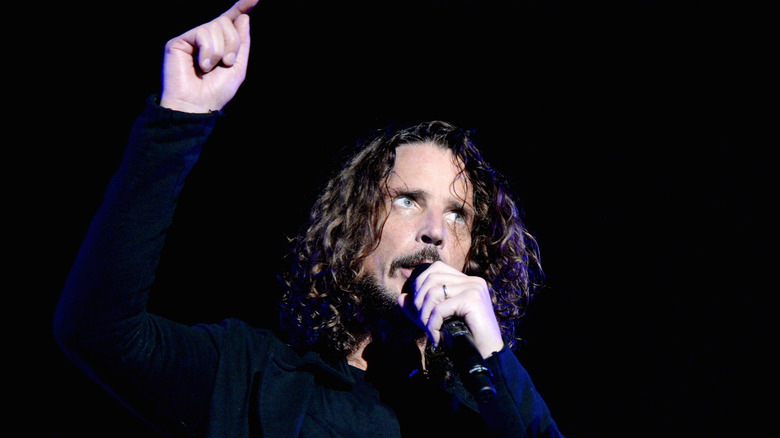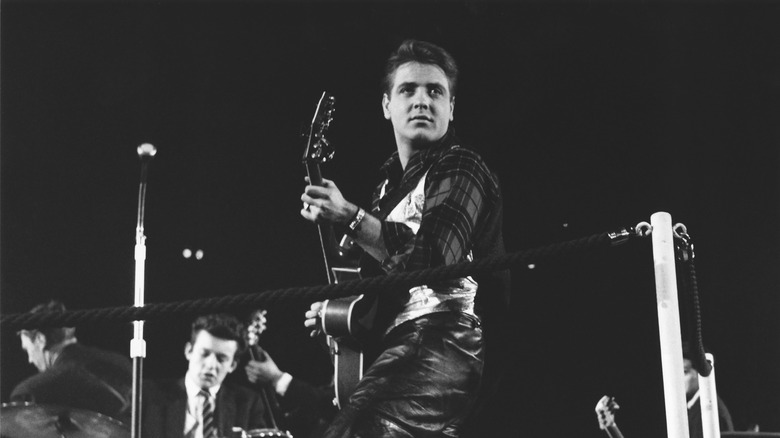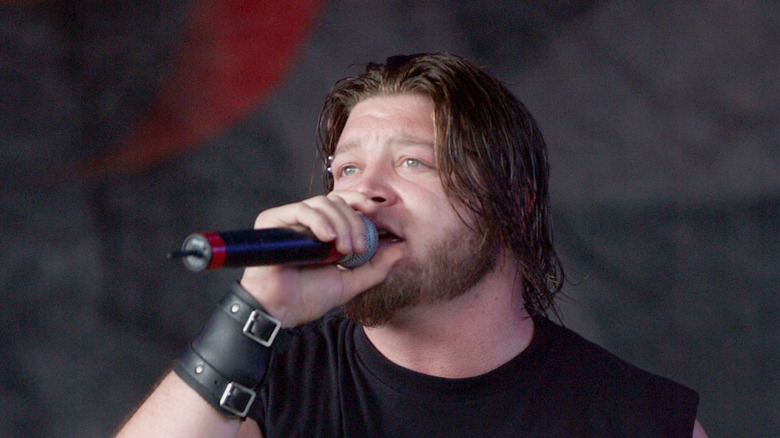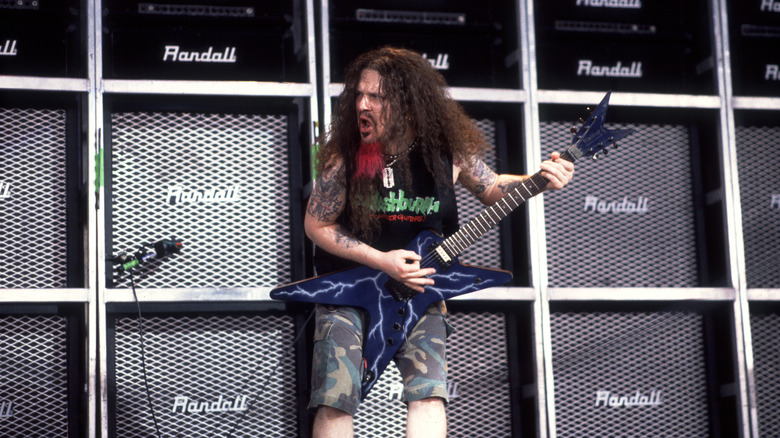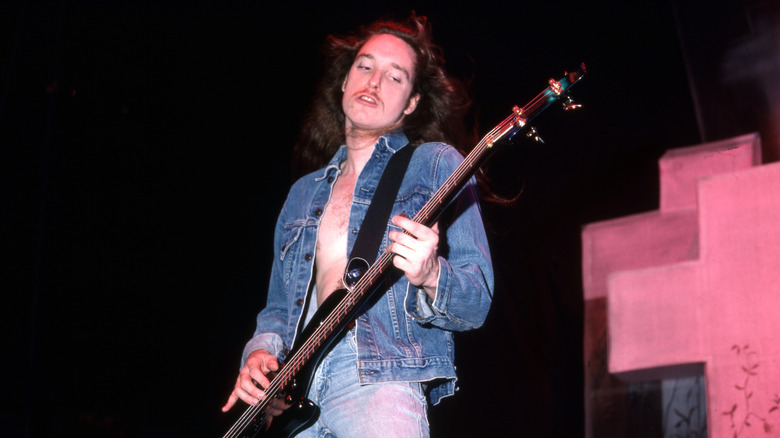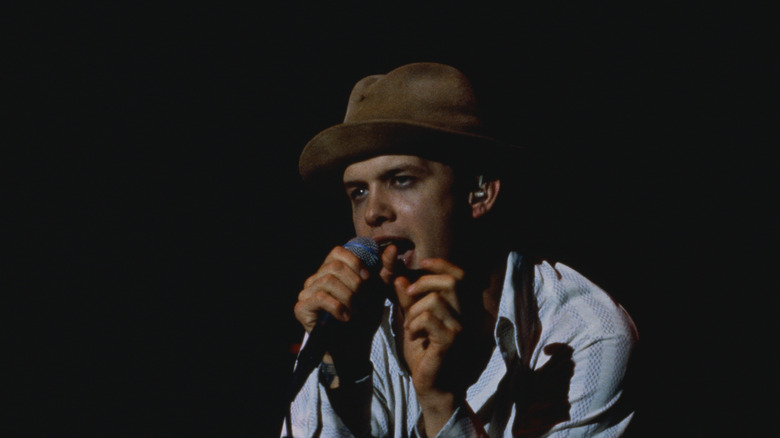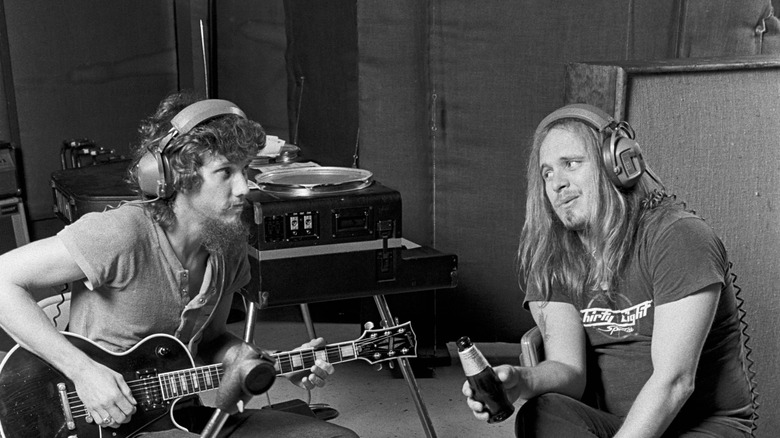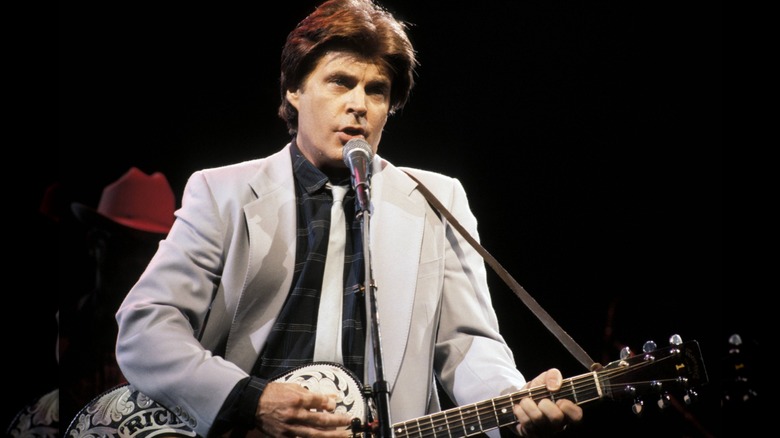Rock Stars Who Died While On Tour
Taking a rock band on tour is a difficult endeavor that involves a lot of people doing everything right in order for it to go smoothly. Of course, things can and do go wrong, which is why many bands have been in tragic accidents while touring. Sometimes, they are lucky enough to come away shaken and injured. Other times, not everyone walks away. But accidents are only one of the ways rock stars can lose their lives on tour.
Over the years, fans have lost their favorite musicians to everything from bus and plane crashes to drug overdoses to suicide, all while the bands were in the middle of touring. For some fans, this means accepting they will never see their heroes play live, while for others, it means grappling with the reality they were there at the last show a musician would ever play. Here are some of the rock stars who died while on tour.
Buddy Holly, Ritchie Valens, and The Big Bopper
Buddy Holly, Ritchie Valens, and J. P. Richardson, best known as "The Big Bopper," infamously perished together in a plane crash, along with their pilot Roger Peterson, on February 3, 1959. Known as "The Day the Music Died," the three musicians were halfway through their 24-show "Winter Dance Party" tour when their plane crashed into a field in Iowa. The tragic explanation of "The Day the Music Died" is that the musicians were 10 days into a 24-date tour and had been using a bus to travel between gigs. But the bus kept breaking down, and that night, the trio decided to take a small plane instead.
A fan named Nancy Ransom Gerardi was in the audience at the Surf Ballroom in Clear Lake, Iowa, for what would end up being the three musicians' final show. "Actually, this was a school night," she told American Blues Scene. "I went to teen dances when I was 13 and loved to dance. So, this was just a very exciting teen dance. It was particularly crowded that night, more so than other dances. You could wander up close to the stage and see them pretty well."
When the news broke, the weight of the tragedy and her proximity to it was hard for her to process. "The next day it was it was extremely crushing to hear what had happened; you just couldn't believe it. You knew for the rest of your life you would remember that you were there."
Scott Weiland
Scott Weiland was most famous as both the former Stone Temple Pilots and Velvet Revolver frontman but was touring in support of the debut album of his new group, Scott Weiland and the Wildabouts, when he died from an accidental overdose in their tour bus before a show in Minnesota on December 3, 2015.
Scott Weiland was nearly broke when he died, which explains why he was touring in the first place. Less than a year before he died, Weiland explained why he was forced to go back on the road, telling the Lebanon Daily News, "It's just astounding that rock records don't sell. They don't sell the way they used to. I never would have imagined that would be the case, but it is the case. ... You don't have records like 'Core' or 'Purple' that sell multi-platinum records anymore. It puts a lot on you to tour."
But being on tour was not necessarily good for the musician, who had been kicked out of the Stone Temple Pilots for being irresponsible. "I had an issue with being late to shows," Weiland told Loudwire. "I can admit that. And it's not just shows ... I've always had a problem with it and my friends call it living on Weiland time." The touring lifestyle may have also been difficult for his ability to stay off drugs. While the year before he died, he proudly stated he had been clean for 13 years, this had clearly changed in the intervening time.
Randy Rhoads
Randy Rhoads was the guitarist who helped define Ozzy Osbourne's sound when the latter went solo after leaving Black Sabbath. But their time working together would be cut tragically short.
On March 19, 1982, during an overnight stop on Osbourne's tour, they parked at a house with a small airstrip in Leesburg, Florida. It turned out the bus driver, Andrew Aycock, had an expired pilot's license, and he decided to take several members of the crew on some joyrides in a small plane — without permission. While Rhoads and the band's seamstress, Rachel Youngblood, were passengers, Aycock buzzed the tour bus where Osbourne and others were sleeping. Then something went wrong and the resulting crash killed all three. What exactly happened on that plane that caused the disaster is still a mystery to this day. It is also questionable why the guitarist even agreed to go up in the plane to begin with since he was afraid of flying. Rhoads was just 25 when he died.
The incident on his tour would affect Osbourne for decades. In 2018, Osbourne told Rolling Stone, "To this day, as I'm talking to you now, I'm back in that field looking at this f***ing plane wreck and a house on fire. You never get over something like that. You're in shock."
Chris Cornell
Chris Cornell was the former lead singer of Soundgarden and Audioslave but was touring as a solo artist when he died by suicide in a Detroit hotel on May 18, 2017, aged 52. This was a shock to everyone from his fans to his family, since there didn't seem to be any warning signs.
The final 12 months of Chris Cornell's life were full of creative endeavors he was thrilled to be working on and things seemed to be going great for him. His wife, Vicky Cornell, told Gayle King (via Billboard), "This was not on the radar. This was not like 'Oh, we have to deal with this' in any sort of way.'" She added, "Chris did not suffer suicidal ideation, and Chris was not even depressed. Chris was in recovery ... It came from nowhere."
Those who saw him only hours before he died didn't see any obvious signs there was a problem, either. He had played a gig that night that went very well. According to a review of the show published in Billboard after Chris died, during the encore he said, "Detroit, you guys ... show up! I feel sorry for the next place we play ... but we don't have the same expectations." This implied, of course, that he planned on playing another show in the future and was not preparing to take his own life. What went wrong after that remains a mystery to his loved ones.
Eddie Cochran
Eddie Cochran might not be a household name today, but he was one of the original American rock 'n' roll stars and one of the first to do a tour in the U.K. This was a huge deal at the time, and the tour was going extremely well. Cochran's manager Norm Riley told MOJO, "Although everybody was telling me that I was wrong, I felt that U.S. hit paraders could tour for a very long time here."
What was originally supposed to be a 12-day tour alongside Gene Vincent had been extended to 20 weeks. But this change in plans necessitated a break in the middle of the now much longer tour, so after playing a show in Bristol on April 17, 1960, Cochran, Vincent, their tour manager Patrick Tompkins, and singer-songwriter Sharon Sheeley hopped into a taxi to head back to London to catch a plane to Los Angeles. Sheeley, who was dating Cochran, remembers thinking that the driver was going way too fast, according to a 1960 article in Photoplay. While tearing through a small town called Chippenham, the car crashed. Everyone survived with only minor injuries — except Cochran, who was gravely injured when he was thrown from the car and died shortly afterward in the hospital. He was 21.
In 1990, the town put up a small plaque in honor of Cochran, and thousands of people visited it every year. After a couple of decades, it was looking worse for wear, so a larger memorial was installed in 2018.
Dave Williams
Dave Williams was the lead singer for Drowning Pool on their platinum-selling debut album. Tragically, he died while performing on the Ozzfest tour on August 14, 2002, aged 30.
Before the singer's sudden death, Drowning Pool had been promoted to a permanent spot on Ozzfest's main stage. According to a record label spokesman, Williams' tour nickname was "The Mayor" because he was "one of those guys who was there for everybody and was loved by everybody he came in contact with. ... He cared more about his fans than most artists and, genuinely, in his heart, gave everything he had every time he was on stage" (via MyPlainview). The night before he died, the tour played a stop in Indiana, and everything seemed fine. Williams was found dead in his bunk on the tour bus the next day.
Because of what rockstars stereotypically get up to while on tour, his death was initially thought to be alcohol-related. But this explanation didn't sit right with some of the people who had actually been with Williams that night. "The band and crew were not up drinking like frat boys, taking drugs etc. We were watching DVDs and I even shut Dave's bunk TV off at 5 a.m. to the sound of his snores," the band's manager, known as Shawdog, explained (via Blabbermouth). In the end, an autopsy showed that Williams died of an undiagnosed heart condition, and his death had nothing to do with drugs or alcohol.
'Dimebag' Darrell Abbott
"Dimebag" Darrell Abbott was most famous as the former guitarist of Pantera, but he was touring with his new band Damageplan when he was murdered onstage by a mentally unwell stalker/fan while on tour in 2004. One detail that makes the death of "Dimebag" Darrell Abbott stranger is that he was shot on December 8, the 24th anniversary of the murder of John Lennon, although there is nothing to indicate that was anything more than a very tragic coincidence.
According to people who were there, the gig that night in Columbus, Ohio was going well. "Dime was doing his thing," said Aaron Benner, a fan who was in the audience and witnessed the shooting told Rolling Stone. "He gets really into it, so he was blindsided." Then a man named Nathan Gale, who had been seen hanging around outside and acting weird before Damageplan took the stage, started shooting. At first, no one understood what was happening. "I thought they were playing a big gimmick," a security guard at the event, Ryan Melchiore, told the magazine. "People were pumping their fists, thinking it was a hoax."
Once it became clear something very bad was happening, people jumped into action. An off-duty nurse started CPR on Abbott, and an off-duty police officer shot Gale. Besides Abbott, Gale killed three other people that night. But no one seemed to understand why. Those who knew him said he was strange, but that they never expected violence from him.
Cliff Burton
The tragic death of Metallica's Cliff Burton has gone down in rock history. Burton was the metal band's bassist from 1982 to 1986, and he took his instrument to another level. Metallica's third album, "Master of Puppets," was a massive hit, which meant their label had them doing shows to support it on a massive world tour.
That's why the band was on a tour bus in Sweden on the night of September 26, 1986. Guitarist Kirk Hammett cut cards with Burton to decide who got the better bunk for the night. Burton won, but that game of chance would result in his death. While the band was sleeping, their bus lost control and went off the road. Burton was thrown from the vehicle before it fell on top of him. During rescue efforts, the crane lifting the bus slipped, and it fell on him again. By the time Burton was extricated, he was dead. He was 24.
The band's manager wanted the tour to continue. "Peter [Mensch] came out and said, 'Get your therapy out through your music — jump right back on the horse and ride on,'" frontman James Hetfield told American Songwriter. "We couldn't believe this guy was telling us this. 'What do you mean, man? This is our buddy. Screw you.' It took us a few days to grasp the concept of that kind of strength. Cliff's wishes were, 'Battle on, friends.'" In the end, they decided to keep going with the tour.
Shannon Hoon
Shannon Hoon was the lead singer of Blind Melon and in 1995, the band was on tour promoting their sophomore album. While their debut had been a massive hit, "Soup" wasn't selling as well. Guitarist Christopher Thorn told Louder, "We were having a lot of fun [because] we were playing and seeing the country, but I think we were a bit stressed out. We didn't realize that you actually had to work a record. ... [Our record company] were more than prepared to keep us on the road for a really long time."
But for some musicians, the stress and lifestyle involved in touring can be dangerous. Hoon had been misusing drugs for years by that point, and touring did not help the situation. "The pitfalls of keeping the band on the road — idle hands are the devil's workshop, and Shannon took that proverb to heart," guitarist Brad Smith explained. "He'd made a mess of himself on the road after a certain point, and we should have gotten off the road sooner. ... But these great tours kept coming up, and the managers were convincing members that we should take advantage of this."
Despite a recent stint in rehab and having a drug counselor on tour with him, Hoon was unable to stay clean. On October 21, 1995, he was found dead on their bus in New Orleans after suffering a heart attack caused by a cocaine overdose. He was 28.
Ronnie Van Zant and Steve Gaines
Lynyrd Skynyrd frontman Ronnie Van Zant and guitarist Steve Gaines tragically died along with four others in a horrific and now-notorious plane crash while on tour. Eerily, Van Zant, who was said to be a little bit psychic, seemed to predict how he would die a few times. "Ronnie and I were in Tokyo, Japan, and Ronnie told me that he'd never live to see 30, and that he was going to go out with his boots on — in other words, on the road," drummer Artimus Pyle explained on an episode of "Behind the Music" (via Rolling Stone).
Lynyrd Skynyrd had played five shows on the "Tour of the Survivors," when they chartered an old plane in South Carolina to take them to their next show in Louisiana. The aircraft had been used by other bands before and was already known to be unsafe. But this did not seem to bother Van Zant. "Ronnie said, 'Hey, if the Lord wants you to die on this plane — when it's your time, it's your time. Let's go, man. We've got a gig to do,'" guitarist Gary Rossington told Rolling Stone.
Partway through the flight, the plane ran out of fuel due to some unknown issue. It crashed in Mississippi, killing six people, including the 29-year-old Van Zant and the 28-year-old Gaines. Twenty others on the plane survived, although 19 of them suffered major injuries.
Rick Nelson
Rick Nelson was one of the first rock 'n' roll stars of the 1950s, although back then he went by Ricky. Introduced to America on "The Adventures of Ozzie and Harriet," which starred his real-life parents, Nelson released many hit songs before fading away in the 1960s.
But nostalgia always sells, so an adult (and using the more mature-sounding name Rick), he was doing a small comeback tour in 1985. He had purchased an older plane to use for transportation, but it suffered from constant mechanical problems. It needed work again before takeoff on December 31; Nelson had played a gig in Alabama the night before. He and his band were scheduled to play that night at a New Year's Eve event in Dallas and were under intense pressure to get there.
Eventually, the plane took off, but whatever problems it had were clearly not fixed. When an onboard fire forced an emergency landing, it crashed. Nelson along with six others died. The two crew members survived. Nelson was 45.
If you or anyone you know needs help, contact the relevant resources below:
-
For addiction issues, go to the Substance Abuse and Mental Health Services Administration website or contact SAMHSA's National Helpline at 1-800-662-HELP (4357).
-
If you or someone you know is struggling or in crisis, help is available. Call or text 988 or chat 988lifeline.org
